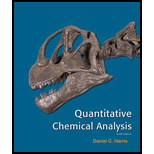
Concept explainers
(a)
Interpretation:
The net reaction for given solutions has to be written.
Concept introduction:
Identifying relevant half-reaction:
Reduction reaction of each half cell have to be identified. In order to identify it, element with two oxidation number should be taken. From the elements reduction reaction for both right and left hand cell is given.
(a)
Explanation of Solution
To write: The net reaction for given solutions.
Elements with two oxidation states are
(b)
Interpretation:
The standard free energy and equilibrium constant of given cell has to be determined.
Concept introduction:
Relation between
(b)
Explanation of Solution
To determine: The standard free energy and equilibrium constant of given cell.
When the potentiometer is replaced with a wire in a cell there would be more current flows and concentration varies until the cell attains equilibrium. At this situation there is nothing to drive reaction. The cell voltage becomes zero.
(c)
Interpretation:
The cell voltage of given cell has to be determined.
Concept introduction:
Nernst Equation:
For Half-reaction,
The Nernst equation results in the half-cell potential E as,
Here,
T =Temperature (in K)
N = number of electrons in half-reaction
F = Faraday constant (
A = Activity of species, i
The voltage of a battery is calculated as
Cell voltage = potential of right hand electrode (
(c)
Explanation of Solution
To determine: The cell voltage of given cell.
Applying the electrode potential in Nernst equation, the cell voltage is calculated as
(d)
Interpretation:
The change in free energy of given cell has to be determined.
Concept introduction:
Relation between change in free energy and change in electric potential:
Here,
n = unit charge per molecule
N = number of electrons in half-reaction
F = Faraday constant (
(d)
Explanation of Solution
To determine: The change in free energy of given cell.
The free energy difference is calculated as
(e)
Interpretation:
The
Concept introduction:
When the potentiometer is replaced with a wire in a cell there would be more current flows and concentration varies until the cell attains equilibrium. At this situation there is nothing to drive reaction. The cell voltage becomes zero.
Relation between
(e)
Explanation of Solution
To determine: The
When the solution is at equilibrium the cell voltage E becomes zero.
Want to see more full solutions like this?
Chapter 14 Solutions
Solution Manual for Quantitative Chemical Analysis
- Name the major organic product of the following action of 4-chloro-4-methyl-1-pentanol in neutral pollution 10+ Now the product. The product has a molecular formula f b. In a singly hain, the starting, material again converts into a secule with the molecular kormula CIO. but with comply Draw the major organic structure inhalationarrow_forwardMacmillan Learning Alcohols can be oxidized by chromic acid derivatives. One such reagent is pyridinium chlorochromate, (C,H,NH*)(CICTO3), commonly known as PCC. Draw the proposed (neutral) intermediate and the organic product in the oxidation of 1-butanol by PCC when carried out in an anhydrous solvent such as CH₂C₁₂. PCC Intermediate OH CH2Cl2 Draw the intermediate. Select Draw Templates More с H Cr о Product Draw the product. Erase Select Draw Templates More H о Erasearrow_forwardIf I have 1-bromopropene, to obtain compound A, I have to add NaOH and another compound. Indicate which compound that would be. A C6H5 CH3arrow_forward
- Provide the reagents for the following reactions.arrow_forwardIf I have 1-bromopropene, to obtain compound Z, I have to add two compounds A1 and A2. Indicate which compounds are needed. P(C6H5)3arrow_forwardDraw the major product of this reaction. Ignore inorganic byproducts. Assume that the water side product is continuously removed to drive the reaction toward products. O CH3CH2NH2, TSOH Select to Draw >arrow_forward
 ChemistryChemistryISBN:9781305957404Author:Steven S. Zumdahl, Susan A. Zumdahl, Donald J. DeCostePublisher:Cengage Learning
ChemistryChemistryISBN:9781305957404Author:Steven S. Zumdahl, Susan A. Zumdahl, Donald J. DeCostePublisher:Cengage Learning ChemistryChemistryISBN:9781259911156Author:Raymond Chang Dr., Jason Overby ProfessorPublisher:McGraw-Hill Education
ChemistryChemistryISBN:9781259911156Author:Raymond Chang Dr., Jason Overby ProfessorPublisher:McGraw-Hill Education Principles of Instrumental AnalysisChemistryISBN:9781305577213Author:Douglas A. Skoog, F. James Holler, Stanley R. CrouchPublisher:Cengage Learning
Principles of Instrumental AnalysisChemistryISBN:9781305577213Author:Douglas A. Skoog, F. James Holler, Stanley R. CrouchPublisher:Cengage Learning Organic ChemistryChemistryISBN:9780078021558Author:Janice Gorzynski Smith Dr.Publisher:McGraw-Hill Education
Organic ChemistryChemistryISBN:9780078021558Author:Janice Gorzynski Smith Dr.Publisher:McGraw-Hill Education Chemistry: Principles and ReactionsChemistryISBN:9781305079373Author:William L. Masterton, Cecile N. HurleyPublisher:Cengage Learning
Chemistry: Principles and ReactionsChemistryISBN:9781305079373Author:William L. Masterton, Cecile N. HurleyPublisher:Cengage Learning Elementary Principles of Chemical Processes, Bind...ChemistryISBN:9781118431221Author:Richard M. Felder, Ronald W. Rousseau, Lisa G. BullardPublisher:WILEY
Elementary Principles of Chemical Processes, Bind...ChemistryISBN:9781118431221Author:Richard M. Felder, Ronald W. Rousseau, Lisa G. BullardPublisher:WILEY





